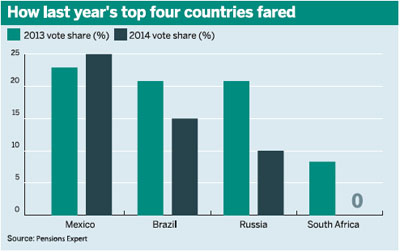For those who desired an object lesson in asset correlation and the worth of diversification under pressure, emerging markets have delivered.
This year’s emerging market debt report finds an asset class battered by weak performance last year, followed by deepening currency and equity problems at the beginning of 2014, undermining the perception of independence in the asset classes.
At the same time, managers and consultants point institutional clients to stronger long-term performance, and argue that market exits can mean market entrances for those with the risk budget to spend.
This week’s analysis will focus on the state of emerging markets themselves – what countries and regions are being targeted by managers – and next week on the risks bedevilling the region.
The bigger picture
Emerging market equity funds saw $12.2bn (£7.5bn) of outflows last month, the Financial Times reported, as investors took money out at the fastest rate since 2011 on concerns of higher local interest rates and political instability.
Whether or not pension fund EMD investors have been hit hard by the volatile market environment of recent weeks will rest upon the type of assets they have bought.
Local currency-denominated debt has suffered at the hands of depreciating economies, while dollar-denominated debt is protected from much of these losses. But that argument only goes so far.
“In really stressful situations, they are very correlated, as we saw last summer,” says Tapan Datta, head of global asset allocation at consultancy Aon Hewitt, pointing to the US Federal Reserve’s announcement of its quantitative easing taper, which spread shockwaves through the markets.
He explains: “Because liquidity is such an issue with this market… the selling can be unselective.”
But the consultancy has not been shaken from its view that, especially in dollar-denominated debt, “drip-feeding” new allocations can make sense.
Neil Williams, chief economist at Hermes Fund Managers, says there are some crucial differences between the current volatility and previous events such as Russia’s 1998 financial crisis and Argentina’s in 2001.
“Firstly, far fewer emerging markets have fixed exchange rates, so they can allow their currencies to fall without exhausting their exchange rates,” he says.
“And the second thing is emerging markets have used the crisis to get their houses in order. So their external debt requirement in dollars, in euros, in yen, in sterling, are far lower then they used to be.”
Pension funds should be selective, rather than placing a blanket ban on emerging markets, he adds: “There are countries that do stand out as having flashing red lights: countries that have the biggest foreign savings needs and those with the shortest debt requirements.”
Where value is to be found
For the second year running, Mexico topped the table of most attractive on EMD, with three-quarters of the managers making it a top-three pick.

The country’s ties to the US and economic prospects continue to make it a go-to investment for managers of pension fund capital.
“Mexico offers a strong growth outlook for this year given its trading relationship with a strongly improving US economy,” said Aaron Grehan, EMD fund manager at Aviva Investors.
Jeff Kalinowski, portfolio specialist at T Rowe Price, says the manager split its assets across local and hard currency as well as investing in corporate debt, looking to take advantage of a developing economy and stronger currency.
“Reform prospects for the country are expected to lead to meaningful productivity gains – especially in the energy sector – which should lead to healthy levels of improvement in GDP growth and currency appreciation,” he explains.
Eyes on Brazil
Ahead of hosting this year’s football World Cup and the 2016 Olympics, nine of the managers surveyed said Brazil was a valuable target for investment.
Kalinowski sees value in the rates on local currency debt. “We also find compelling value in many of the companies operating in Brazil, most notably via the beef sector and industrials,” he adds.
William Ledward, portfolio manager of the Franklin Templeton Emerging Market Debt Opportunities Fund, agrees. “The real has depreciated a long way, and we believe now offers good value.”
Russia was picked as a target by six managers, with Brett Diment, head of EMD at Aberdeen Asset Management, voicing hopes that the country’s monetary policy would move to the benefit of external investors.

“The dovish orientation of the new central bank governor should ensure that the central bank will follow its peers and start to cut interest rates, which should be supportive for the local bond market which has lagged its neighbours.”
In addition, Jerome Booth, emerging markets commentator and chair of private office New Sparta, observes: “The really important thing about Russia is the growth of the consumer [class].
“There is an economy without much debt that has been doing structural reforms,” Booth adds.
On Booth’s reading, institutional investors are overexposed to developing markets to the detriment of their beneficiaries, and should be making larger allocations to the asset class.
Argentina, Venezuela and Ukraine are the only three countries on the index that pension funds should steer clear of, he says. “[With] all the others in the index, you can pretty much relax.”














